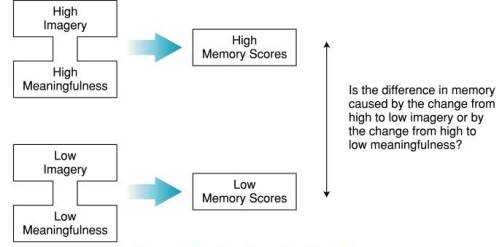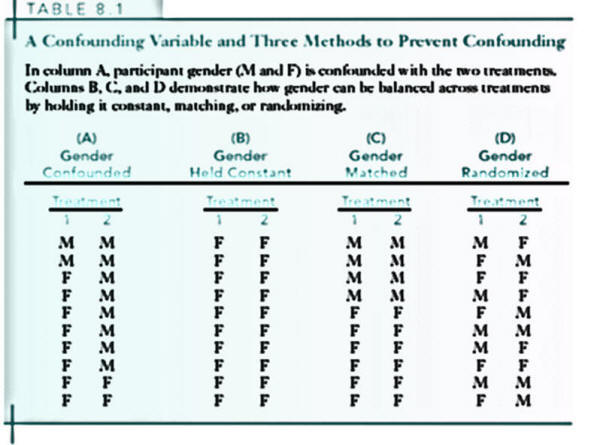
Psy
What is the goal of the experimental
research strategy?
A. The Third-Variable Problem
Problem—variables often exist as a web of
interrelated variables…
Because two variables are related to one
another does not mean that there is a causal relationship—that one causes the
other.
B. The Directionality Problem
Which variable is the cause and which is the effect?
C. Controlling Nature
The variables under investigation are isolated from the influence of other variables. What's the danger in this?
II. Elements of an Experiment
General Goal: Establish a cause-and-effect relationship
Characteristics unique to experiments:
MANIPULATION and CONTROL
A. Manipulation & Measurement
Manipulation—the
factor that is presumed to be the cause is manipulated as an independent
variable
Comparison is an essential feature of experiments
Independent Variable (IV)
Dependent Variable (DV)
Do you really know this stuff?
B. Control & Extraneous Variables
To show that the manipulated variable is
responsible for the changes observed in the dependent variable, experiment must
rule out any other possible explanation for the observed changes.
What is a confounding variable?
III. Dealing with Confounding & Extraneous Variables

What is an extraneous variable?
How is an extraneous variable different than a confounding variable?
What is the relationship between them?
Must we take measures to control every extraneous variable?
Is it a problem if an extraneous variable changes randomly with the independent variable?
Is it a problem if an extraneous variable
changes systematically with the independent variable?
Three general categories of extraneous variables :
(1) Participant variables
(2) Environmental variables
(3) Time-Related variables
control by holding constant
control by matching across conditions
control by randomization

Experimental group vs. Control group
No-Treatment Control Groups
Placebo Control Groups
A measure to see whether the independent variable has the intended effect on the participant.
Two ways to check the manipulation:
(1) An explicit measure of the IV
(2) Ask specific questions about the manipulation after the experiment
VI. Quasi-Experimental Strategy
Aim to establish a tentative cause and effect relationship between two variables but cannot satisfy all of the strict requirements needed for a true experiment (often cannot not meet all of the above requirements in a natural settings)
Uses some of the rigor and control used in true experiments. But in some way, lack the control found in true experiments (usually lack random assignment of participants to conditions), so ability to draw a causal inference is impaired
**If participant variables are of interest, then can not possible randomly assign participants to conditions, right? How do we safeguard internal validity?
Structure of between-subjects designs

A separate group of participants is assigned to each of the different conditions by using random selection.
Groups are presumed to be equal at start so that we can conclude any difference in DV is due to effect of IV.
In order to assure equivalent groups, the groups must be created equally, treated equally, and composed of equivalent individuals.
Advantages & Disadvantages of Between-Subjects Designs
Pro: Each participant is exposed to only one treatment condition. Therefore, score is free from the following influences: (1) practice/experience, (2) fatigue/boredom, and (3) contrast effects. Also, usable for wide variety of research questions.
Cons: (1) Need relatively large N and (2)each score is obtained from a different person--all possessing different characteristics.
Characteristics of Within-Subjects Designs
Uses a single sample of individuals and tests each individual in all treatment conditions of the experiment
The "ultimate" equivalent groups design
Often called repeated-measures design

Advantages
Fewer participants
Major advantage--eliminates all problems concerning individual differences
Disadvantages
Because each participant is experiencing more than one condition, potential
exists for:
Carryover effects--participating in one condition produces a change in participants that affects their performance in subsequent conditions. (caused by experience in a particular treatment condition)
Progressive error--performance changes not because of the treatment but because of experience over time (caused by the general experience of participating in an experiment)
Common types of progressive error--fatigue and practice effects
How do we deal with carryover effects and progressive error?
Counterbalance the order of conditions